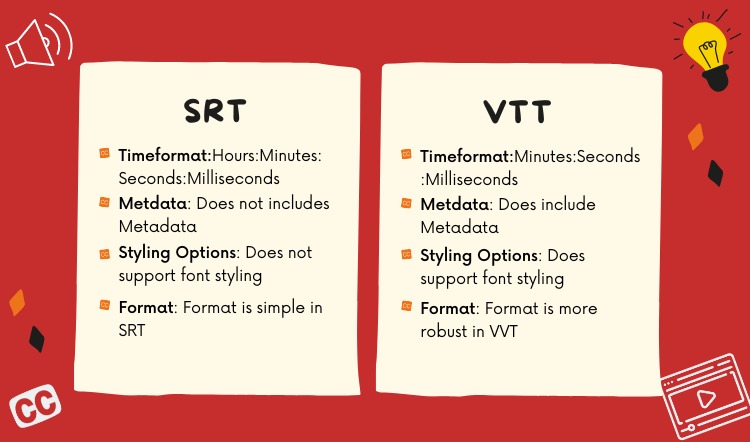Creating videos without subtitles or captions is like singing on the stage with the microphone turned off. Sure, the people around you can hear, but what about the one in the back row?
The success of your video can be greatly affected by how well it is captioned. Be it, social media videos, web series, movies, talk shows, educational videos, or anything else.
Studies show that Subtitles increase video viewing by 40% and where subtitles appeared, 80% more people watched the entire video.
Subtitles and Closed Captions – The Difference
Closed captions and subtitles appear pretty similar at first glance, but the differences that distinguish them aren’t as subtle as they appear.
A subtitle provides a text alternative to the spoken words in a video, while a closed caption also describes other sounds that are meaningful to the story, like an engine struggling to start or a cell phone ringing.
The choice between the two can have a far greater impact on how audiences perceive your brand than you might expect.
Subtitles bridge the language barriers and reach a larger audience. It takes the video content to a global audience.
Closed captions, on the other hand, not only transcript the dialogues but also other relevant background noises and audio cues that require description. It makes your video more accessible for the deaf and hard-of-hearing audience.
Why should you caption your videos?
Let us talk a little about the reasons you should caption your videos.
Videos know no borders
International shows and movies (not originally produced in English) have gained popularity. Thanks to OTT.
Parasite, Squid Games, Dark, and Narcos and Money Heist are just a few examples of shows that originated in local languages but are now worldwide hits. There is no doubt that subtitles contributed to their success.
Videos with captions are able to cross borders, cultures, and barriers, and reach everyone out there, which is precisely what is required for the success of your video.
Make your videos more accessible
Have you ever watched a movie without any audio and enjoyed it? Leave alone enjoying the movie,I bet there were atleast a couple of scenes that made no sense to you.
It is estimated that over 5% of the world’s population has significant hearing loss. This means, 460 million people will be unable to access your content without captions.
Boost User Experience
Imagine you are watching one of your favorite show while sipping coffee in a cafe, the blaring sound from your phone would definitely turn heads to you and there will always be some disturbance caused by the background noise.
According to a study by Digiday, 85% of the videos on Facebook are being watched without sound and just with the help of subtitles and captions.
You can watch a video with subtitles and audio off regardless of whether you are in an office or library and still understand what is being said.
Thus captions, help to hold the attention of your audience. This means your videos get watched completely and this inturn helps your videos rank better in search engines.
Drink up the SEO juice
Search engines can not watch your video or listen to the audio, all they can do isindex text. With a transcript, you can make sure that search engines are able to index your multimedia content effectively.
Sure you can optimize your video title and description, but can you cover every single thing on the video. This is where captions help. In fact if you caption your video in the VTT format (we will talk more about that in the next section) you can also add metadata about the person speaking. All this helps the search engine understand your conten and see through it, thus improving discoverability
How to Subtitle a Video
There are two commonly used formats for closed captioning a video, They are SRT and VTT.
Though SRT doesn’t include metadata or styling options like bells and whistles that VTT supports, some of the social media video players like Facebook player support only the SRT format of captioning.
While selecting the subtitle or captions format, consider what you’re trying to accomplish with it.
Once, you have decided upon the format, go about creating one for your videos. You can either do it manually or use a captioning service on the web.
The next step is to add these subtitles to your videos. An efficient video CMS would allow you to simply upload the SRT or VTT file in multiple languages to your videos.
Most importantly, your audience must be able to toggle between caption on and off and also choose their preferred language.
All of Us Are Dead – Case Study
Korean-language zombie apocalypse horror series All of Us Are Dead shot straight into the top the most watched TV series list in 91 countries. It also drew 361 million viewing hours in its first 10 days!
Hitting the most watched list is not something new for the Korean entertainment industry. Would have the world celebrated these content without captions and subtitles. No. Why would you watch a movie if you can’t understand a word of it.
Today, bingeable popcorns go with shows like Lupin (French) and Tehran (Israeli) which were not actually made for English speaking audience. Thanks to the internet and captions.
Takeaway
You may think adding subtitles and captions to video content is a lot of work. However they improve content clarity, accessibility and exposure to a wider audience.
Try experimenting by captioning some of your videos and study their performance, then you would understand the value it brings to your service.






